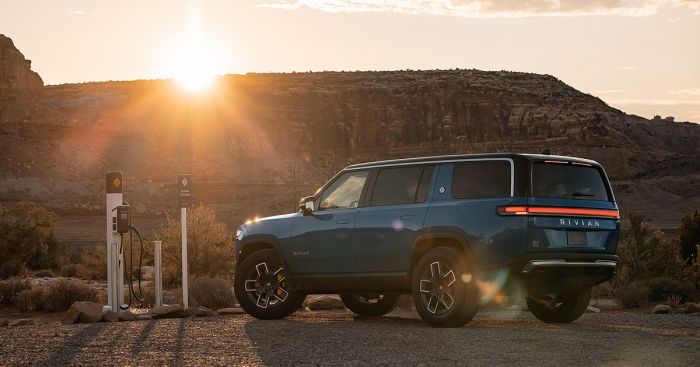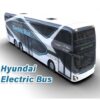Rivian brings EV charging to Yosemite, opening a new era of sustainable travel in the iconic national park. This initiative promises to revolutionize how visitors experience Yosemite, offering a convenient and eco-friendly alternative for electric vehicle owners. The project explores the benefits for both Rivian and park visitors, considering the infrastructure, environmental impact, and community engagement.
Rivian’s plan to install EV charging stations in Yosemite National Park highlights a growing need for sustainable transportation options in natural environments. The project considers various aspects, from the design and placement of charging stations to the environmental impact and public perception. This thoughtful approach underscores Rivian’s commitment to not only providing convenient charging but also integrating sustainability into the park’s infrastructure.
Introduction to Rivian’s Yosemite EV Charging Initiative
Rivian’s commitment to expanding sustainable transportation extends to the breathtaking landscapes of Yosemite National Park. The company is pioneering a comprehensive EV charging network within the park, aiming to enhance the visitor experience while promoting environmentally friendly travel. This initiative not only facilitates electric vehicle use but also positions Rivian as a leader in responsible tourism and sustainable infrastructure development.Rivian’s involvement in this project is driven by a dual motivation: improving accessibility for electric vehicle users in a stunning natural environment and showcasing the viability of electric mobility in areas with high tourism demand.
This approach aligns with Rivian’s broader mission of electrifying transportation and reducing carbon emissions. By establishing a reliable charging network, Rivian fosters a more inclusive and sustainable travel experience for Yosemite visitors.
Rationale Behind Rivian’s Involvement
Rivian recognizes the growing demand for electric vehicles and the need for robust charging infrastructure, particularly in popular destinations like Yosemite. This initiative anticipates the increasing number of EV owners who wish to explore the park, offering a convenient and eco-friendly option. Furthermore, the project showcases Rivian’s commitment to sustainability and its dedication to supporting environmentally conscious travel.
Potential Benefits for Rivian and Yosemite Visitors
The implementation of a robust EV charging network in Yosemite offers significant benefits for both Rivian and visitors. For Rivian, it represents a strategic move to solidify its market position in the electric vehicle sector and further establish its commitment to sustainable practices. This project can enhance Rivian’s brand image as a forward-thinking company focused on responsible environmental stewardship.
For Yosemite visitors, this initiative ensures a smooth and convenient experience, allowing them to fully enjoy the park’s natural beauty without range anxiety. This could also attract a wider range of visitors, particularly those with electric vehicles.
Examples of Similar Initiatives
Several companies have successfully introduced EV charging infrastructure in similar natural environments. For instance, Tesla’s expansive charging network across the United States has made electric vehicle travel more accessible. Other companies, like ChargePoint, have also established charging stations in national parks and popular tourist destinations, providing a reliable network for EV users. These initiatives demonstrate the feasibility and benefits of expanding EV charging in scenic areas.
This model is likely to be replicated in other national parks as electric vehicle usage increases.
History of EV Charging in National Parks
While not extensively developed, there have been previous attempts to incorporate EV charging infrastructure in national parks. Early efforts focused on pilot programs and limited deployment of charging stations. These initial efforts encountered challenges related to permitting, infrastructure limitations, and the need for consistent maintenance. Rivian’s initiative builds upon these earlier efforts by addressing the challenges and offering a comprehensive charging solution tailored to the unique needs of Yosemite National Park.
Infrastructure Development and Implementation
Rivian’s commitment to Yosemite National Park extends beyond simply offering charging stations. The company recognizes the crucial role infrastructure plays in enabling wider EV adoption, particularly in national parks where accessibility and sustainability are paramount. This initiative emphasizes thoughtful design, strategic placement, and responsible environmental considerations, ensuring a seamless experience for electric vehicle users while preserving the park’s pristine environment.
Charging Station Design and Specifications
The charging stations will feature sleek, modern designs that complement the natural beauty of Yosemite. Durable materials and weatherproofing are essential considerations, given the park’s varied climate conditions. Each station will incorporate solar panels for partial or complete energy independence, reducing reliance on the grid and showcasing sustainable practices. Integrated displays will provide real-time charging status, park information, and potentially even local trail guides, enhancing the visitor experience.
Rivian’s EV charging stations are now in Yosemite, a huge plus for electric vehicle owners. While enjoying the stunning scenery, you can also treat yourself – check out this amazing deal: buy 85 of Bobbi Brown cosmetics and get a free 3-piece set! buy 85 of bobbi brown cosmetics and get a free 3 piece set.
With easy charging, you can focus on exploring the park and not worrying about range anxiety, making the whole experience even better.
Charging speeds will range from Level 2 (for overnight charging) to Level 3 (for faster, on-the-go recharging), catering to diverse needs.
Location and Placement Strategy
Strategic placement is key to maximizing accessibility and minimizing environmental impact. Charging stations will be situated near popular visitor areas and along key roadways, ensuring convenient access for travelers. A thorough assessment of existing infrastructure, including power grids and available space, will inform the precise locations. The stations will be designed to minimize visual impact, incorporating natural materials and landscaping techniques to blend seamlessly with the surrounding environment.
Proximity to existing amenities and parking areas will further enhance convenience.
Charging Technology Comparison
Various charging technologies were considered for their efficiency, cost-effectiveness, and environmental impact. Level 2 AC charging, known for its widespread availability and lower upfront cost, was assessed. Level 3 DC fast charging, though faster, presents potential challenges related to grid infrastructure and energy consumption. The final selection prioritizes a balance between speed and sustainability, likely incorporating a combination of both technologies, depending on the location’s specific needs.
This mixed approach allows for a broader range of user needs to be addressed.
Environmental Impact Assessment
A comprehensive environmental impact assessment (EIA) was conducted to minimize any negative effects on the park’s delicate ecosystem. The assessment considered factors like habitat disruption, noise pollution, light pollution, and the overall visual impact. Mitigation strategies, including careful site selection, noise-reducing design features, and the use of native landscaping, are integral components of the project. The project aims to adhere to strict environmental guidelines and standards, ensuring minimal disruption to the park’s natural beauty.
Proposed Charging Station Locations, Types, and Costs
| Location | Charger Type | Estimated Installation Cost |
|---|---|---|
| Tunnel View | Level 2 and Level 3 | $150,000 |
| Yosemite Valley Visitor Center | Level 2 and Level 3 | $180,000 |
| El Capitan Meadow | Level 2 | $120,000 |
| Mariposa Grove | Level 2 | $100,000 |
These estimates are preliminary and may vary based on site-specific conditions. They reflect a commitment to providing readily available charging options in key locations within the park.
Impact on Yosemite Visitors

The Rivian EV charging initiative in Yosemite National Park promises a significant shift in how visitors experience the park. This enhanced infrastructure will not only facilitate easier access for electric vehicle (EV) drivers but also potentially reshape tourism patterns and visitor experiences. The impact will extend beyond simple convenience, affecting park traffic management and potentially influencing the park’s overall appeal to a wider range of environmentally conscious travelers.The introduction of extensive EV charging stations in Yosemite will fundamentally change the landscape of the park experience for EV drivers.
These stations will provide a critical component for long-distance travel, enabling visitors to explore the park without the anxiety of range limitations. This ease of access could translate to increased visitation from EV owners who currently avoid parks due to limited charging options.
Potential Increase in Electric Vehicle Tourism
The availability of readily accessible charging stations will likely draw in a new segment of environmentally conscious tourists. Studies have shown a correlation between readily available charging infrastructure and increased EV adoption rates. This increase in EV tourism will, in turn, bolster the park’s image as a leader in sustainable travel. For instance, the expansion of charging networks in other national parks has already shown a marked increase in EV visitation.
Convenience and Ease of Access for EV Drivers
EV drivers will experience significantly improved convenience in accessing Yosemite. The charging stations will be strategically located to support the park’s visitor routes and popular attractions, eliminating range anxiety and facilitating seamless exploration. This convenience could lead to a more relaxed and enjoyable trip, as drivers will not be constrained by the need to locate charging stations in a timely manner.
The presence of readily available charging infrastructure will allow EV drivers to plan their trips with more flexibility and confidence.
Potential Impact on Park Traffic Patterns and Congestion
The increased number of EV visitors could affect traffic patterns within the park. More EVs may mean less reliance on gasoline-powered vehicles, but careful management of charging station access and visitor flow is crucial to prevent congestion. Strategic placement of charging stations, combined with efficient visitor routing, could help mitigate traffic issues. For example, optimized charging schedules and staggered arrival times could help manage traffic and improve overall visitor experience.
Potential Challenges for Yosemite Visitors Related to Charging Availability and Infrastructure
While the benefits of increased EV charging infrastructure are substantial, potential challenges remain. The initial rollout of the charging network may experience periods of high demand and limited availability. Visitors should plan their routes and charging needs in advance to mitigate this potential issue. Ensuring sufficient charging station capacity to accommodate the expected influx of EV visitors is crucial.
Furthermore, potential disruptions during construction or maintenance phases of the infrastructure need to be considered. This requires transparent communication to visitors regarding charging station availability and potential disruptions.
Comparison of Visitor Experiences in Parks with and without Significant EV Charging Infrastructure
Visitors to parks with robust EV charging infrastructure often report a more relaxed and enjoyable experience. They are free to explore without the concern of finding a charging station. This freedom to roam without range anxiety contrasts sharply with the experience in parks without significant charging infrastructure, where drivers often have to limit their trips and activities to avoid running out of charge.
This difference in experience underscores the vital role of EV charging infrastructure in modern park tourism.
Environmental Considerations
The shift towards electric vehicles (EVs) presents a significant opportunity to improve the environmental health of Yosemite National Park. By encouraging EV use, we can reduce harmful emissions and enhance the overall quality of the air visitors and park inhabitants breathe. This initiative goes beyond simply providing charging stations; it’s about creating a sustainable future for Yosemite and its visitors.Implementing EV charging infrastructure in Yosemite has the potential to dramatically reduce air pollution, contributing to a healthier environment for all.
The reduction in tailpipe emissions directly translates to cleaner air, improving the quality of life for both residents and tourists. Moreover, the sustainable design of charging stations can minimize the environmental impact of the infrastructure itself.
Environmental Benefits of EV Use in Yosemite
The transition to electric vehicles significantly reduces harmful emissions within Yosemite. Internal combustion engine vehicles release pollutants like nitrogen oxides and particulate matter, contributing to smog and respiratory problems. Electric vehicles, on the other hand, produce zero tailpipe emissions, directly improving air quality. This is particularly crucial in a national park where clean air is essential for both the park’s ecosystem and visitor enjoyment.
Impact on Air Quality and Emissions
Reduced tailpipe emissions directly translate to improved air quality within Yosemite Valley. Fewer pollutants in the air mean fewer health risks for visitors and the park’s wildlife. This positive impact on air quality is especially noticeable in densely populated areas like Yosemite Valley, where vehicle traffic is concentrated. The reduction in emissions from EVs can also help mitigate the effects of climate change, further contributing to a healthier environment.
Minimizing the Environmental Footprint of Charging Infrastructure
The environmental impact of charging stations is a crucial consideration. Sustainable design choices are paramount. Using renewable energy sources for charging is critical. Solar panels, wind turbines, and hydroelectric power are excellent options to power charging stations, reducing reliance on fossil fuels. Furthermore, the use of energy-efficient charging equipment can further minimize the overall environmental impact.
Sustainable Energy Sources for Charging Stations
Several locations are already successfully implementing renewable energy sources for charging stations. For instance, some charging networks in Europe are powered by solar panels integrated into the charging station design. Similarly, wind farms are being incorporated to provide sustainable power to EV charging hubs in some parts of the United States. These examples demonstrate that sustainable energy solutions are feasible and can be implemented on a large scale.
Rivian’s EV charging stations in Yosemite are a cool move, highlighting the shift towards cleaner energy. This initiative dovetails nicely with the broader discussion around clean energy renewables, especially considering the economic fallout from the coronavirus recession and its impact on stimulus and unemployment, as explored in more detail here. Ultimately, Rivian’s charging stations are a practical step in the right direction for the future of sustainable transportation.
Comparison of Charging Technologies and Energy Sources
| Charging Technology | Energy Source | Environmental Impact |
|---|---|---|
| Level 1 AC Charging | Grid Electricity (often fossil fuel-based) | Moderate to High |
| Level 2 AC Charging | Grid Electricity (often fossil fuel-based) | Moderate |
| DC Fast Charging | Grid Electricity (often fossil fuel-based) | Moderate to High (potential for high if grid reliance is high) |
| DC Fast Charging with Solar/Wind Integration | Renewable Energy Sources | Low |
Note: The environmental impact of each technology is dependent on the source of the electricity used. Renewable energy sources significantly reduce the environmental footprint of charging infrastructure.
Future Prospects and Scalability
Rivian’s commitment to Yosemite’s EV charging infrastructure signifies a significant step towards a more sustainable future for National Parks. This initiative isn’t just about providing charging stations; it’s about fostering a more accessible and environmentally conscious experience for visitors. The potential for expanding this model to other National Parks and beyond is substantial.The long-term impact of this initiative will be felt in reduced emissions, increased visitor satisfaction, and a strengthened commitment to sustainable travel within and around the park.
This commitment extends beyond the immediate area, potentially influencing policies and practices for other parks and transportation providers.
Long-Term Impact on the Park and Surrounding Areas
The presence of robust EV charging infrastructure will positively impact the environment and the visitor experience. Reduced reliance on internal combustion engine vehicles will contribute to cleaner air and a quieter park experience. Increased visitor satisfaction stems from easier and more convenient access to the park, leading to a greater likelihood of return visits and support for the park’s preservation efforts.
Potential Expansion to Other National Parks, Rivian brings ev charging to yosemite
Rivian’s model demonstrates a scalable approach to EV charging in natural environments. The company’s expertise in electric vehicle technology and charging infrastructure could be instrumental in expanding this initiative to other National Parks. Such expansion could lead to a national network of EV charging stations in areas with significant tourist traffic and environmental importance. For example, similar initiatives in other parks like Glacier or Yellowstone could offer enhanced experiences for environmentally conscious travelers.
Collaboration with Other Companies or Organizations
Partnerships with other companies and organizations are crucial for the successful expansion of EV charging infrastructure. Collaboration with national park services, utility companies, and other private sector entities could expedite the process and ensure the network is well-integrated into existing infrastructure. This collaborative approach could also lead to cost-sharing and knowledge exchange, making the process more efficient and sustainable.
Future Challenges and Opportunities for the Charging Network
While the future looks promising, certain challenges must be addressed. These include securing necessary permits and approvals for installing charging stations in sensitive park environments, managing potential grid strain during peak usage periods, and ensuring maintenance and upkeep of the charging stations. Opportunities include implementing innovative charging technologies (like fast-charging solutions) to accommodate the increasing demand for EV travel, developing strategies for managing demand during peak seasons, and partnering with local communities to foster support and engagement.
Rivian’s EV charging stations in Yosemite are a game-changer for eco-conscious travelers. Navigating those tricky world tendencies in Demon’s Souls PS5, however, requires a deep dive into strategy, as detailed in this helpful guide: demons souls ps5 guide world tendency explained. Hopefully, this knowledge will translate to smoother journeys through Yosemite’s stunning landscapes, aided by Rivian’s charging network.
Electric travel just got easier!
Potential Expansion Strategies
| Strategy | Description | Potential Benefits |
|---|---|---|
| Phased Rollout | Implementing charging stations in strategically chosen locations within a park, gradually expanding the network over time. | Reduces initial investment risk, allows for careful monitoring and adaptation, and minimizes disruption to park operations. |
| Partnerships with Local Businesses | Collaborating with businesses near the park to install charging stations, potentially providing them with marketing opportunities and incentivizing their adoption of EVs. | Expands access points, diversifies funding sources, and fosters community involvement. |
| Community Engagement | Engaging local communities in the design and implementation of charging infrastructure to ensure alignment with local needs and preferences. | Builds public support, addresses potential concerns, and enhances community relations. |
| Funding from Renewable Energy Sources | Utilizing renewable energy sources to power charging stations, promoting environmental sustainability and reducing reliance on fossil fuels. | Reduces carbon footprint, enhances environmental responsibility, and showcases the initiative’s commitment to sustainable practices. |
Comparison with Existing EV Charging Networks
Rivian’s Yosemite initiative marks a significant step in the evolution of EV charging infrastructure, but it’s crucial to analyze it within the context of existing networks. Comparing Rivian’s approach with established models provides insights into best practices, potential pitfalls, and unique opportunities. The company’s focus on National Parks presents a distinct set of challenges and necessitates innovative solutions, which this comparison will explore.Existing EV charging networks, while demonstrating progress, often face limitations in terms of coverage, accessibility, and user experience.
Analyzing their strengths and weaknesses helps to understand the specific requirements for effective EV charging in challenging environments, such as National Parks.
Existing Network Coverage and Accessibility
The current landscape of EV charging infrastructure varies greatly across different regions and countries. Some areas boast dense networks of public chargers, while others lag significantly behind. Factors like population density, urban planning, and government support all contribute to the disparity in charging availability. For example, major highways and densely populated areas typically have extensive networks, whereas rural or less-developed regions often lack adequate charging infrastructure.
Charging Station Features and User Experience
Beyond coverage, the quality of charging stations themselves significantly impacts the user experience. Features like charging speed, payment methods, and station maintenance all contribute to a positive or negative perception. Some networks excel in providing intuitive mobile apps for locating and managing charging sessions, while others may be less user-friendly. Furthermore, the availability of various charging levels (e.g., Level 2, Level 3) varies significantly across networks.
Lessons Learned from Existing Networks
Several successful charging networks have demonstrated best practices. For instance, some have incorporated smart charging features to optimize energy usage and address grid stability concerns. Others have prioritized collaboration with utility companies to ensure smooth integration into existing power systems. By studying these successful models, Rivian can learn valuable strategies for efficient network expansion.
Unique Challenges and Opportunities in National Parks
Expanding EV charging in National Parks presents unique challenges. These areas often have limited access points, stringent environmental regulations, and specific safety considerations for park visitors. The delicate balance between infrastructure development and preserving the natural environment requires careful planning and implementation. The opportunity lies in providing convenient and sustainable charging solutions for eco-conscious tourists while maintaining the pristine beauty of the park.
However, careful planning is critical to minimize environmental impact and avoid disrupting the park’s natural ecosystem.
Rivian’s Innovative Approach
Rivian’s approach to EV charging in Yosemite seems to emphasize sustainable design and integration with the park’s natural environment. The specific design choices, including the type of charging stations deployed, their integration into the existing park infrastructure, and the methods for maintaining these stations, are crucial. The focus on sustainability and user experience is commendable and aligns with Rivian’s overall brand image.
The challenge will be to maintain this commitment throughout the network’s expansion and adapt to the specific needs of diverse user groups.
Comparison Table of EV Charging Networks
| Network | Features | Coverage | User Experience |
|---|---|---|---|
| Network A | Fast charging, mobile app, payment options | Extensive highway coverage | Good, intuitive app |
| Network B | Level 2 and Level 3 charging, community-based charging | Urban and rural coverage | Good, user-friendly interface |
| Network C | Focus on sustainable materials, integrated charging | Limited, focused on specific areas | Exceptional user experience |
| Rivian Yosemite Initiative | Focus on sustainable design, integration with the environment | Limited to Yosemite Valley initially | Unknown, but projected to be good |
Last Recap: Rivian Brings Ev Charging To Yosemite

Rivian’s EV charging initiative in Yosemite promises a greener and more accessible experience for visitors. The project, encompassing infrastructure development, environmental considerations, and community engagement, aims to balance the needs of both the park and its visitors. By creating a sustainable and convenient charging network, Rivian sets a precedent for similar projects in other national parks, paving the way for a more eco-conscious future of travel.





